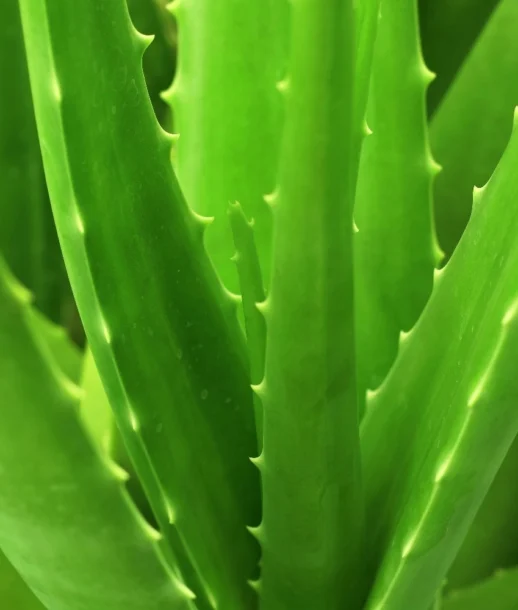Aloe vera is a succulent plant that has been used for centuries for its medicinal and skin care properties. It is native to Africa, but is now cultivated in tropical and subtropical regions around the world. The gel inside the leaves of aloe vera is the part that is most commonly used. It is a clear, viscous substance that contains a variety of vitamins, minerals, and antioxidants. Aloe vera gel has been shown to have a number of health benefits, including:
- Anti-inflammatory: Aloe vera gel can help to reduce inflammation, which can be helpful for a variety of conditions, including acne, eczema, and psoriasis.
- Wound healing: Aloe vera gel can help to promote wound healing by stimulating the production of new skin cells. It is often used to treat burns, cuts, and other skin injuries.
- Antibacterial: Aloe vera gel has antibacterial properties that can help to fight infection. It can be applied to cuts and scrapes to help prevent infection.
- Moisturizing: Aloe vera gel is a natural moisturizer that can help to keep the skin hydrated. It is often used to treat dry skin, sunburn, and chapped lips.
- Sun protection: Aloe vera gel can help to protect the skin from the sun’s harmful rays. It is often used after sun exposure to help soothe sunburned skin.
In addition to these health benefits, aloe vera gel is also used in a variety of cosmetic products, such as lotions, creams, and shampoos. It is a popular ingredient for skin care products because it can help to keep the skin hydrated and healthy.
Aloe vera is generally safe to use, but there are some potential side effects, such as allergic reactions and diarrhea. It is important to talk to your doctor before using aloe vera if you have any underlying health conditions.
Here are some of the most common uses of aloe vera:
- Soothing burns and healing wounds: Aloe vera gel is a natural antiseptic and can help to reduce inflammation and pain. It is often used to treat burns, cuts, and scrapes.
- Eases intestinal problems: Aloe vera gel has been shown to have laxative properties and can help to relieve constipation. It can also help to reduce inflammation in the gut.
- Reduces arthritic swelling: Aloe vera gel has anti-inflammatory properties that can help to reduce joint pain and swelling.
- Heals psoriasis lesions: Aloe vera gel can help to reduce inflammation and itching in psoriasis lesions. It can also help to speed up the healing process.
- Gum infections: Aloe vera gel has antibacterial properties that can help to fight gum infections. It can be applied directly to the gums or used as a mouthwash.
- Eye irritations and injuries: Aloe vera gel can help to soothe and heal irritated eyes. It can also be used to treat minor eye injuries.
- Strains and sprains: Aloe vera gel can help to reduce pain and inflammation in strains and sprains. It can be applied directly to the affected area or used as a compress.
- Lung congestion: Aloe vera gel has expectorant properties that can help to loosen mucus and relieve lung congestion. It can be taken by mouth or inhaled as a vapor.
Biological Sources –
The biological source of aloe vera is the dried latex of leaves of the Aloe barbadensis miller plant. It is also known as curacao aloe, cape aloe and socotrine aloe. It belongs to the liliaceae family.
Botanical description –
- Stem: The stem of an aloe vera plant is short and stout. It is usually green in color, but it can also be brown or yellow.
- Leaves: The leaves of an aloe vera plant are thick and fleshy. They are arranged in a rosette formation around the stem. The leaves are green to gray-green in color and have serrated edges. The leaves are also covered in a waxy coating that helps to protect them from the sun.
- Petiole: The petiole is the stalk that connects the leaf to the stem. It is usually green in color, but it can also be brown or yellow.
- Blade: The blade is the flat part of the leaf. It is where the gel is found. The blade is usually green in color, but it can also be gray-green or yellow.
- Gel: The gel is the clear, viscous substance that is found inside the leaves of aloe vera, It is made up of a variety of compounds, including vitamins, minerals, and antioxidants.
- Sap: The sap is the bitter yellow liquid that is found inside the leaves of aloe vera. It contains anthraquinones, which are compounds that have laxative properties.
Chemical Constituents –
The major chemical constituents are –
- Vitamins: Aloe vera contains vitamins A, C, E, and B12. These vitamins are important for maintaining good health and well-being.
- Minerals: Aloe vera contains minerals such as calcium, magnesium, potassium, and zinc. These minerals are also important for maintaining good health.
- Sugars: Aloe vera contains sugars such as glucose, fructose, and mannose. These sugars provide energy and help to keep the body hydrated.
- Polysaccharides: Aloe vera contains polysaccharides such as acemannan and glucomannan. These polysaccharides have a number of health benefits, including promoting wound healing and reducing inflammation.
- Anthraquinones: Aloe vera contains anthraquinones such as aloe-emodin and aloin. These anthraquinones have laxative properties.
- Flavonoids: Aloe vera contains flavonoids such as quercetin and kaempferol. These flavonoids have antioxidant properties.
- Enzymes: Aloe vera contains enzymes such as amylase, lipase, and catalase. These enzymes help to break down food and promote digestion.
- Saponins: Aloe vera contains saponins such as aloin and barbaloin. These saponins have antibacterial and antifungal properties.

